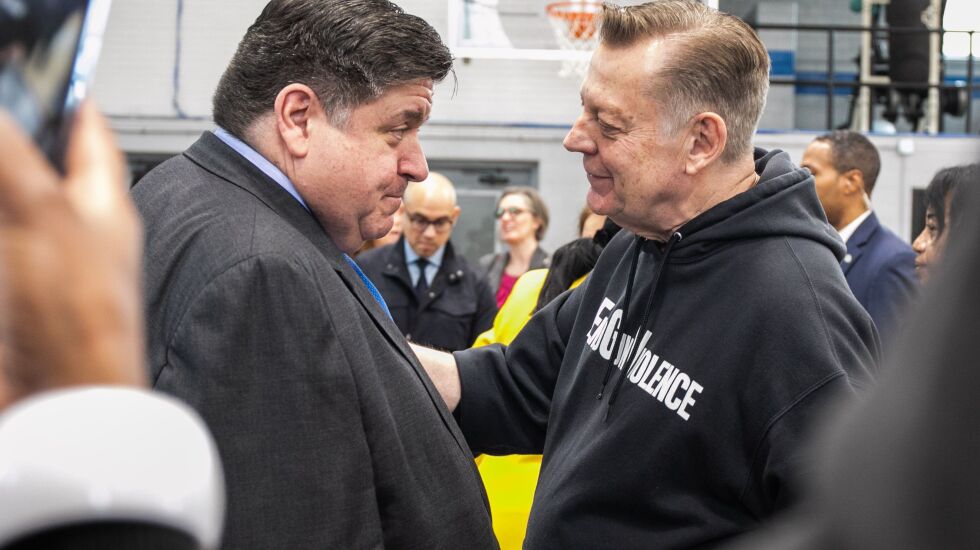
The long Memorial Day weekend is the unofficial start of summer and is perhaps best known in Chicago as the beginning of its long, hot season of gun violence. The morning-after news coverage typically notes the holiday “was the most violent weekend of the year so far,” or some such thing.
You’ve probably seen the polling that shows crime isn’t the super-hot political issue it’s often portrayed to be. But don’t kid yourself. It’s still high enough on voters’ lists to make a difference, usually coming in second behind economic issues.
That’s one reason why Gov. J.B. Pritzker sent out a press release last week touting his violence reduction efforts, including “surging” $18 million in new state funding for a thousand summer jobs in Chicago for kids in “high-risk” situations. He claimed in the release that $10 million has already been released to groups ahead of the summer.
The governor’s office told me the Illinois Department of Human Services has sent $83 million “out the door” this fiscal year to community providers for anti-violence efforts. It also says $27.2 million is “heading out in the next month, before the end of the fiscal year on June 30.
That spending, the Pritzker administration says, is up from the $60 million spent by IDHS in all of last fiscal year. In addition, the administration points to $113 million in grants available to groups through the department’s notice of funding opportunity process.
Considering that the city of Chicago alone is directly spending $1.7 billion this fiscal year on law enforcement, these are relatively modest programs. But the state money is still a decent pile of cash.
And because the state largesse is being spent by individual grant recipients, there’s always the danger it could be misused or misdirected.
Just ask former Gov. Pat Quinn, who took an enormous amount of political heat for the way some of his $54 million anti-violence Neighborhood Funding Initiative Program money was spent in 2010, leading up to the election.
Quinn was slammed for various silly attempts to keep kids off the street, up to and including paying kids to march in a parade with the governor. Nothing much ever came of the various probes into the program, but, even if there was no criminal intent, its execution was a complete mess and ill-conceived. The last thing Pritzker needs is a re-run.
Some Democratic state legislators have been pushing news media outlets to write stories about how their favored anti-violence groups haven’t received more funding, but the governor’s office has resisted in certain instances where the groups would likely draw unfavorable attention from those very same media outlets.
The Pritzker people have taken a different approach than Quinn, and hopefully (for the governor’s own sake and for the state’s) they won’t be making the same sort of mistakes as the last Democratic governor.
Even so, it’s likely that somebody will screw up somewhere and wind up on the front page of a newspaper or the leading item during a TV newscast. Violence interruption and prevention programs rarely get the benefit of the doubt from the news media. From the coverage, it would be easy to conclude that Quinn’s program had far more downsides than upsides. Because of that, it took years and years before the state legislature was willing to give the concept another chance.
On the other hand, if there’s too much caution, then not enough grant money arrives in time for the summer, which would be a PR disaster. It’s also worth noting that it often takes a month or more for groups to complete the paperwork and navigate the various processes to actually receive grant monies after the cash has been awarded by the state.
So, even though the state can claim the money is “out the door,” the funds may not yet be available to spend.
But this should be more than just about the fact the state is spending money. It’s crucial these programs actually show some real, tangible results.
Chicago and most smaller cities in this state have been gut-punched by violent crime. Police officers and replacement recruits are in short supply here and throughout the country. Violence interruption and prevention needs to show tangible results, not only for the present, but for the future. Convincing the General Assembly to support more programs down the road could turn out to be nearly impossible if this fails.
So, please, everybody, don’t screw it up.
Rich Miller also publishes Capitol Fax, a daily political newsletter, and CapitolFax.com.
Send letters to letters@suntimes.com







